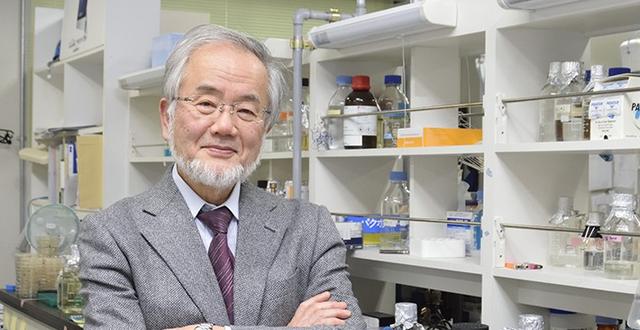(单词翻译:单击)
听力文本
This is Scientific American — 60-Second Science. I'm Steve Mirsky.
Got a minute?
The 2016 Nobel Prize in Physiology or Medicine goes to Yoshinori Ohsumi of Japan for his discoveries of mechanisms of what's known as autophagy. Break the word down and you get auto and phagy: from the Greek for self, auto, and eating, phagein. So, self-eating. Autophagy refers to a process in cells whereby they destroy themselves and send the parts out for recycling. Cells do this by enclosing their contents in tiny sacks, called vesicles. Those vesicles then get transported to an organelle within the cell called the lysosome. Where the sacks get degraded and the contents are made available for reuse.
Autophagy had been observed a half-century before Ohsumi's work in the 1990's while at the University of Tokyo. But it was his research that made clear its fundamental importance. He did that work with baker's yeast. One way he made his discoveries was to interfere with the process and thus see vesicles involved in autophagy start to build up—this action proved that yeast cells performed autophagy. He went on to identify 15 genes crucial for the process.

Need quick fuel for energy? Autophagy makes that fuel available fast. Need raw materials for maintenance in other cells? Autophagy gets those materials into the system so the body can respond to starvation and other stresses. Infected? Autophagy plays a part in capturing and killing bacteria and viruses. It clears out damaged proteins and organelles, thus helping to fight the effects of aging. At the other end of the life cycle, autophagy is involved in the development of embryos. It's truly a fundamental process.
Ohsumi is 71 years old. He's currently an emeritus professor at the Tokyo Institute of Technology. The Nobel Prize comes with a monetary award of about $1.2 million.
Thanks for the minute for Scientific American — 60-Second Science Science. I'm Steve Mirsky.
参考译文
这里是科学美国人——60秒科学。我是史蒂夫·米尔斯基。
有一分钟时间吗?
2016年诺贝尔生理学或医学奖授予日本科学家大隅良典,以表彰他他发现了细胞自噬机制。将autophagy这个词分解开来,就会得到auto和phagy,从希腊词汇来讲,auto是自我的意思,而phagy则是吃的意思。所以,autophagy就是“自噬”。“自噬”是细胞毁灭自己然后将某些部分运输出去回收的过程。细胞将自己包裹在一个小袋子里,这个小袋子叫做囊泡。之后囊泡被运输到细胞内被称为溶酶体的细胞器中。在溶酶体里,这些囊泡会被降解,里面的物质也就可以被重新利用。
大隅在20世纪90年代时在东京大学工作,而自噬则在早于那个时期的半个世纪以前就被人们所发现。但是大隅良典的研究明确了自噬的重要性。他用面包酵母进行研究。他在研究中采用的其中一种方法是干扰自噬过程,这样可以看到囊泡会在自噬之前开始积累,这一行动证明了酵母细胞也进行自噬。他随后又继续确认了15个在自噬过程中很关键的基因。
需要快速能量供给吗?自噬可使燃料获得进程加快。需要维持其它细胞的原材料?自噬可以为体内提供燃料,这样身体就可以应对饥饿和其它生理压力。感染了吗?自噬在捕获和消灭细菌及病毒的过程中起到一定的作用。它会清除掉损坏的蛋白质和细胞器,从而帮助老化带来的问题。在生命周期的另一端,自噬会参与到胚胎发育过程中。它是真正的基本过程。
大隅良典今年71岁。他目前是东京工业大学的名誉教授。他将获得约120万美元的诺贝尔奖金。
谢谢大家收听科学美国人——60秒科学。我是史蒂夫·米尔斯基。
译文为可可英语翻译,未经授权请勿转载!
重点讲解
重点讲解:
1. break down 分解;将…分成若干部分;
例句:The next step is to use bacteria to break down the algae into natural gas and different chemicals.
下一步就是用细菌把海藻分解成天然气和不同的化学物质。
2. interfere with 妨碍;冲突;抵触;
例句:It will seriously interfere with the progress of the work.
这将严重妨碍工作的进行。
3. build up (使)积聚;(使)逐渐增加;
例句:Don't let your resentment build up.
别让你的怨恨郁积起来。
4. clear out 清除;
例句:Our old stock has been entirely cleared out.
我们旧的存货已全部出清。
5. be involved in 卷入的;参与的;与…有密切关联的;
例句:He was proved to be involved in the case.
他被证明与这件事有牵连。


